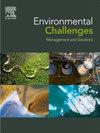Heavy metal bioaccumulation in sediments and mussels along the moroccan mediterranean coast: A spatial assessment
Q2 Environmental Science
引用次数: 0
Abstract
Due to its strategic location and rapid development, the Moroccan Mediterranean coast is particularly vulnerable to trace metal contamination. This study examines the spatial distribution of selected heavy metals in surface marine sediments and in the tissues of the mussel Mytilus galloprovincialis, a species widely consumed by humans and other animals, from six strategically chosen coastal stations. Sediment and mussel samples were collected and analyzed using atomic absorption spectrometry (Varian AA 20 AAS) and inductively coupled plasma optical emission spectrometry (ICP-OES 720-ES), respectively. In sediments, the metal concentrations decreased in the following order: Zn > Cu > Cr > Pb > Fe > Cd, with chromium reaching a maximum concentration of 45 mg/kg at the most contaminated site. In mussel tissues, the sequence was Fe > Zn > Cu > Cr > Cd > Pb, with iron concentrations peaking at 524 mg/kg. Pearson correlation analysis revealed moderate relationships between metal concentrations in sediments and mussels for most elements, except for Fe and Zn, while multiple regression analysis indicated that cadmium levels in sediments significantly influenced Cd bioaccumulation in mussels. Although our enrichment factor analysis suggests relative anthropogenic input, the overall metal loads remain low—a result likely attributable to the sandy nature of the sediments and active hydrodynamics that limit material retention. Collectively, these findings provide critical baseline data on metal bioavailability in this dynamic coastal system and have important implications for ecological risk assessment and food safety management in the region.
摩洛哥地中海沿岸沉积物和贻贝中的重金属生物积累:空间评估
由于其战略位置和快速发展,摩洛哥地中海沿岸特别容易受到微量金属污染。本研究从六个战略选择的沿海站考察了表层海洋沉积物和人类和其他动物广泛食用的贻贝(Mytilus galloprovincialis)组织中选定重金属的空间分布。采用原子吸收光谱法(Varian AA 20 AAS)和电感耦合等离子体发射光谱法(ICP-OES 720-ES)对沉积物和贻贝样品进行分析。沉积物中金属含量的递减顺序为:Zn >;铜比;Cr祝辞Pb祝辞菲比;镉,在污染最严重的地方,铬的最高浓度达到45毫克/公斤。在贻贝组织中,序列为Fe >;锌比;铜比;Cr祝辞Cd比;铅,铁浓度在524 mg/kg时达到峰值。Pearson相关分析显示,除Fe和Zn外,沉积物中大多数元素的金属浓度与贻贝体内Cd的生物积累量呈正相关,而多元回归分析表明,沉积物中镉水平对贻贝体内Cd的生物积累有显著影响。虽然我们的富集因子分析表明相对的人为输入,但总体金属负荷仍然很低,这可能是由于沉积物的沙质性质和活跃的水动力学限制了物质滞留。总的来说,这些发现提供了这一动态沿海系统中金属生物利用度的关键基线数据,并对该地区的生态风险评估和食品安全管理具有重要意义。
本文章由计算机程序翻译,如有差异,请以英文原文为准。
求助全文
约1分钟内获得全文
求助全文
来源期刊

Environmental Challenges
Environmental Science-Environmental Engineering
CiteScore
8.00
自引率
0.00%
发文量
249
审稿时长
8 weeks
 求助内容:
求助内容: 应助结果提醒方式:
应助结果提醒方式:


